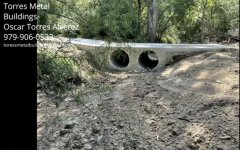garymartin63965
Member
- Joined
- Jan 5, 2023
- Messages
- 36
- Tractor
- 1955 Ford 860
I have a fry creek that runs across my driveway. After heavy rains the water runs through & will get up to 3-4’ deep and might run 60-70’ wide. I want to hire a dozer to come and clean the creek bed up (push gravel to the banks and straighten the run a bit. After that I would like to install two 36” HDPE culvert pipes. The plan is to trench out a footing on the upstream side 24” deep under the culverts, pour concrete in the trench, pour 12” of concrete on each side of the culverts as well as between them. Use 3/4” minus to fill any voids in the driveway and ‘level’ it out. After that I’ll pour a 6” concrete slab on top with #3 rebar 12”OC. The upstream side would be concrete (to keep the water from getting under the bridge) & footings would be on each end of the slab. This is the only access I have to my house & property and it would need to be able to stand up to occasional heavy traffic. ( concrete trucks, logging trucks, triple axle trailers & such) Will in work? Am I going overboard, do I need more ‘fill’ over the culvert. TIA for your help.I will try and post an example of the bridge I thinking of.
garymartin63965
garymartin63965
